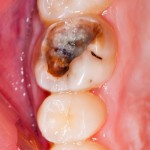
Deep caries has been defined radiographically as a condition where the teeth are damaged to 1/3 or 1/4 of the dentine near the dental pulp or suffer from a risk of dental pulp exposure. Traditionally management involved the removal of all demineralised tissues and bacterially contaminated tissues and replacement with various filling materials. Increasingly more conservative approaches such as stepwise removal, a two-stage approach where soft dentine is initially removed and a temporary filling placed or selective removal were partial removal of carious dentine and restoration is completed at a single stage, are being used.
The aim of this review was to compare the efficacy of stepwise removal (SWR) and selective removal (SCR) in the management of deep carious lesions in primary and permanent teeth.
Methods
Searches were conducted in the Cochrane library, PubMed, Embase, Web of Science, CNKI, WanFang, and VIP databases by two reviewers. Randomised controlled trials (RCTs) of patients with deep caries undergoing stepwise removal (SWR) or selective removal (SCR) and published in English or Chinese were considered. Success was the primary outcome. Secondary outcomes included pulp exposure, tooth extraction, pulp necrosis, pulpitis, and endodontic treatment. Two reviewers extracted data and assessed study quality using the modified Jadad scale. Effect size was expressed as relative risk (RR) with 95% confidence intervals (CI).
Results
- 9 RCTs involving 1550 patients (1929 teeth – 952 SCR group, 922 SWR group).
- 5 studies involved permanent teeth, 3 studies primary teeth and one study permanent and primary teeth.
- The included studies were published between 2010 and 2021
- 5 studies were considered to be of high quality and 4 of low quality.
- Success was assessed in 7 studies producing 8 data sets with statistically higher success shown for SCR than SWR except for primary teeth and follow up > 36 months (see table below)
| Success rates | RR (95%CI) |
| Overall | 1.123 (1.056 to 1.194) |
| Primary teeth | 1.035 (0.942 to 1.138) * |
| Permanent teeth | 1.142 (1.075 to 1.214) |
| < 24 months | 1.087 (1.010 to 1.169) |
| 24-36 months | 1.193 (1.106 to 1.287) |
| > 36 months | 1.123 (0.885 to 1.426) * |
*not significant
- Statistically significant benefits in favour of SCR were seen for the secondary outcomes of pulp exposure, pulp necrosis and pulpitis (see table below)
| Outcome | No. of studies | RR (95%CI) |
| Pulp exposure | 4 | 0.266 (0.096 to 0.740) |
| Tooth extraction | 4 | 1.628 (0.400 to 6.630) * |
| Pulp necrosis | 2 | 0.142 (0.026 to 0.789) |
| Pulpitis | 2 | 0.237 (0.090 to 0.623) |
| Endodontic treatment | 3 | 0.681 (0.270 to 1.721) * |
*not significant
Conclusions
The authors concluded: –
SCR brought a higher success rate as well as lower incidences of pulp exposure, pulp necrosis and pulpitis than SWR for patients with deep carious lesions. More investigations are necessary to reinforce our points.
Comments
Recently the Cochrane review by Schwendicke et al, looked more broadly at interventions for treating cavitated or dentine carious lesions in permanent or primary teeth including both SCR and SWR (Dental Elf – 21st Jul 2021). This new review specifically compares SCR and SWR including 9 RCTs only two of which were included in the Cochrane review. The review authors have searched a good range of databases planning to include studies in English and Chinese although all the included publications were in English. 5 of the included studies were considered to be of high quality although the modified Jadad scale was used for assessment, and this is not currently recommended. While the findings suggest that overall selective removal performed better than stepwise this should be interpreted cautiously particularly in relation to the secondary outcomes which were only reported in a small number of studies. Additional high quality well reported studies with appropriate sample sizes would help improve the precision of estimates of effectiveness.
Links
Primary Paper
Yao Y, Luo A, Hao Y. Selective versus stepwise removal of deep carious lesions: A meta-analysis of randomized controlled trials. J Dent Sci. 2023 Jan;18(1):17-26. doi: 10.1016/j.jds.2022.07.021. Epub 2022 Aug 21. PMID: 36643250; PMCID: PMC9831820.
Other references
Dental Elf – 21st Jul 2021
Dental Elf – 6th Mar 2020
